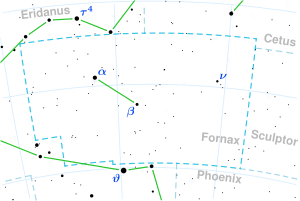Gamma1 Fornacis
Appearance
| Observation data Epoch J2000.0 Equinox J2000.0 (ICRS) | |
|---|---|
| Constellation | Fornax |
| Right ascension | 02h 49m 50.96148s[1] |
| Declination | −24° 33′ 37.1306″[1] |
| Apparent magnitude (V) | 6.154[2] |
| Characteristics | |
| Spectral type | G9 III[3] |
| Astrometry | |
| Radial velocity (Rv) | −6.10 ± 0.7[4] km/s |
| Proper motion (μ) | RA: −50.75 ± 0.55[1] mas/yr Dec.: −129.61 ± 0.46[1] mas/yr |
| Parallax (π) | 7.48 ± 0.52 mas[1] |
| Distance | 440 ± 30 ly (134 ± 9 pc) |
| Absolute magnitude (MV) | +0.52[2] |
| Details | |
| Mass | 1.11[2] M☉ |
| Luminosity | 79.72[5] L☉ |
| Surface gravity (log g) | 2.60[2] cgs |
| Temperature | 4700[5] K |
| Metallicity [Fe/H] | −0.02[2] dex |
| Other designations | |
| Database references | |
| SIMBAD | data |
Gamma1 Fornacis (γ1 For) is a star in the constellation Fornax. Its apparent magnitude is 6.15. It is a yellow giant that has swollen and brightened to around 80 times as luminous as the Sun.
γ1 Fornacis has three companions listed in the Washington Double Star Catalog. These are faint 11th - 13th magnitude stars at 11' - 56' distance from γ1.[6] Gamma2 Fornacis is a 5th magnitude star four degrees to the south.
References
- ^ a b c d e Van Leeuwen, F. (2007). "Validation of the new Hipparcos reduction". Astronomy and Astrophysics. 474 (2): 653. arXiv:0708.1752. Bibcode:2007A&A...474..653V. doi:10.1051/0004-6361:20078357.
- ^ a b c d e Luck, R. Earle; Heiter, Ulrike (2007). "Giants in the Local Region". The Astronomical Journal. 133 (6): 2464. Bibcode:2007AJ....133.2464L. doi:10.1086/513194.
- ^ Abt, Helmut A. (2008). "Visual Multiples. IX. MK Spectral Types". The Astrophysical Journal Supplement Series. 176: 216–217. Bibcode:2008ApJS..176..216A. doi:10.1086/525529.
- ^ Gontcharov, G. A. (2006). "Pulkovo Compilation of Radial Velocities for 35 495 Hipparcos stars in a common system". Astronomy Letters. 32 (11): 759. arXiv:1606.08053. Bibcode:2006AstL...32..759G. doi:10.1134/S1063773706110065.
- ^ a b McDonald, I.; Zijlstra, A. A.; Boyer, M. L. (2012). "Fundamental Parameters and Infrared Excesses of Hipparcos Stars". Monthly Notices of the Royal Astronomical Society. 427 (1): 343–57. arXiv:1208.2037. Bibcode:2012MNRAS.427..343M. doi:10.1111/j.1365-2966.2012.21873.x.
{{cite journal}}: CS1 maint: unflagged free DOI (link) - ^ Mason, Brian D.; Wycoff, Gary L.; Hartkopf, William I.; Douglass, Geoffrey G.; Worley, Charles E. (2001). "The 2001 US Naval Observatory Double Star CD-ROM. I. The Washington Double Star Catalog". The Astronomical Journal. 122 (6): 3466. Bibcode:2001AJ....122.3466M. doi:10.1086/323920.

